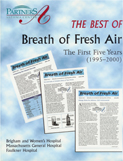Breath of Fresh Air: Feature Articles
Chapter 5: Antihistamines
|
Spring is here and in New England plant life is, as the old
song goes, "busting out all over." Pollens are in the air
and for many people this is a season of itchy and watery
eyes and nose and possibly increased asthmatic symptoms. It
is a good opportunity for us to consider the role of
antihistamines in the treatment of allergic diseases and to
offer some guidance in choosing among the various
antihistamines available. Histamine is a chemical released by cells in the body
during allergic reactions. Some effects of histamine
include swelling and itching (such as in the lining of the
eyes and nose) and constriction of the breathing tubes. In
the 1940s, the first medications effective in blocking the
actions of histamine became available. In recent years,
improvements in these medications have led to newer, more
powerful antihistamines with fewer unwanted side effects.
These newer antihistamines are sometimes referred to as the
"second generation" of antihistamines, and they are
available only by prescription. |
Medications to block histamine first became available in the 1940's. |
|
|
Antihistamines work well to prevent or relieve allergic
symptoms in the eyes and nose. Unfortunately, they have
little effect on asthmatic symptoms. It turns out that
histamine is only one of many chemicals that can cause
narrowing of the bronchial tubes, and antihistamines leave
these other chemicals unopposed. Antihistamines begin to
work about one hour after they are swallowed. Their maximum
effect occurs about 4-5 hours after taking the medication.
Most of the antihistamines prevent or relieve symptoms for
12-24 hours. They are most effective when started at the
beginning of allergy season and taken regularly throughout
the season. They also work when taken only as needed for
intermittent relief of symptoms. The older, "first-generation" antihistamines can have
many undesirable side effects, the most prominent of which
are sleepiness and difficulty concentrating. Some of these
medications are sold over-the-counter as sleeping pills.
One has to be particularly careful to avoid drinking
alcohol when taking these medications. On the other hand,
despite what you have read on the warning labels on
over-the-counter antihistamines, they probably do not pose
any serious risk for causing worsened asthma. Antihistamines work well for allergic symptoms in the eyes and nose, but have little effect on asthmatic symptoms. |
Antihistamines work well for allergic symptoms in the eyes and nose, but have little effect on asthmatic symptoms. |
|
|
The "second-generation" antihistamines, in general, do not cause sleepiness or trouble concentrating. Two of these antihistamines, terfenadine (Seldane®) and astemizole (Hismanal®), caused rare but serious irregular heart
rhythms and were taken off the market. One drawback of the
newer antihistamines is their cost, as shown in the
accompanying Table. |
Antihistamines work best when taken
regularly throughout allergy season. |
|
|
Both over-the-counter and prescription antihistamines are often sold in combination with decongestants. Decongestants are medications that constrict the blood vessels, helping to reduce swelling and mucus formation, particularly in the nose. The combination of antihistamines and decongestants is often more effective than either alone for treating allergic reactions of the nose, but decongestants come with their own set of possible side effects, including jitteriness, insomnia, and a tendency toward elevation of the blood pressure. Still other options are available for treating allergic reactions in the eyes and nose in the form of nasal sprays and topical eye drops. For instance, nasal steroid sprays offer an alternative to antihistamines, with or without decongestants, for treating allergic reactions of the nose. To decide which option is best for you, talk to your doctor. And we wish you clear breathing this Spring. |
Antihistamines and decongestants are often
sold in combination. |

